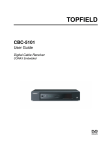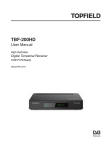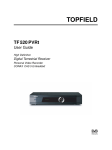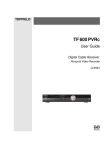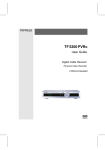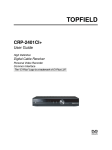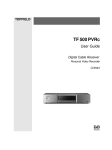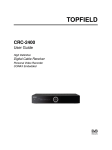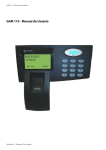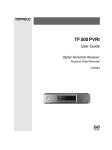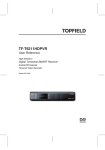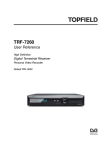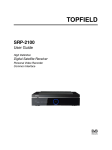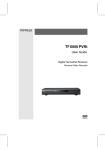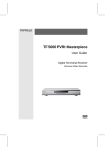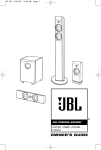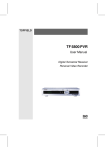Download TF520PVRc User Guide
Transcript
TOPFIELD TF 520 PVRc User Guide High Definition Digital Cable Receiver Personal Video Recorder CONAX CAS 5 Embedded ii CONTENTS Contents Contents 1 . . . . . . . . . . . . . . . . . . . . . . . . . . . . . . . . . . . . . . . . . . . . . . . . . . . . . . . 1 1 2 2 4 6 Setup 2.1 Unpacking . . . . . . . . . . . . . . . . . . . 2.2 Safety precautions . . . . . . . . . . . . . . . 2.3 Rear panel connections . . . . . . . . . . . . 2.4 Connecting up your digital receiver . . . . . 2.4.1 Connecting to the broadcasting cable 2.4.2 Connecting to your television set . . 2.4.3 Connecting to your video recorder . 2.5 Switching on for the first time . . . . . . . . . . . . . . . . . . . . . . . . . . . . . . . . . . . . . . . . . . . . . . . . . . . . . . . . . . . . . . . . . . . . . . . . . . . . . . . . . . . . . . . . 7 7 7 9 11 12 12 15 15 3 Service Search 3.1 Searching for broadcasting services . . . . . . . . . . . . . . . 3.2 Resetting to factory settings . . . . . . . . . . . . . . . . . . . 3.3 Clearing the services list . . . . . . . . . . . . . . . . . . . . . 17 17 18 19 4 Preference Settings 20 2 Introduction 1.1 Features . . . . . . . . . . . . . 1.2 Controlling the digital receiver . 1.2.1 Front panel . . . . . . . 1.2.2 Remote control . . . . . 1.3 Subscription card information . ii . . . . . . . . . . . . . . . . . . . . . . . . . . . . . . CONTENTS iii 4.1 . . . . . . . . . . . . . . . . . . . . . . . . . . . . . . . . . . . . . . . . . . . . . . . . . . . . . . . . . . . . . . . . . . . . . . . . . . . . . . . . . . . . . . . . . . . . . . . . . . . . . . . . . . . . . . . . . . . . . . . . . . . . . . . . . . . . . . . . . . . . . . . . . . . . . . . . . . . . . . . . 20 20 21 21 21 22 22 23 24 24 25 25 25 27 28 29 Every Day Use 5.1 Volume control . . . . . . . . . . . . . . . . . 5.2 Watching television . . . . . . . . . . . . . . . 5.2.1 The services list . . . . . . . . . . . . . 5.2.2 The favourite service lists . . . . . . . 5.2.3 Viewing programme information . . . 5.2.4 Selecting audio tracks . . . . . . . . . 5.2.5 Selecting subtitle tracks . . . . . . . . 5.2.6 Viewing teletext . . . . . . . . . . . . . 5.3 Viewing electronic programme guide . . . . . 5.4 Watching multifeed programme . . . . . . . . 5.5 Using time-shift . . . . . . . . . . . . . . . . . 5.6 Viewing in the picture-in-picture screen mode . . . . . . . . . . . . . . . . . . . . . . . . . . . . . . . . . . . . . . . . . . . . . . . . . . . . . . . . . . . . . . . . . . . . . . . . . . . . . . . . . . . . . . . . . . . . . . . . . . . . . . . . . . . . 30 30 30 30 32 33 34 34 34 35 35 36 37 Organising Services 6.1 Editing the favourite lists . . . . . . . . . . . . . . . . . . . . . 6.2 How to use on-screen keyboard . . . . . . . . . . . . . . . . . 6.3 Transferring receiver data . . . . . . . . . . . . . . . . . . . . 39 39 41 41 4.2 4.3 4.4 4.5 4.6 5 6 Language settings . . . . . . . . . 4.1.1 Menu language . . . . . . 4.1.2 Subtitle language . . . . . 4.1.3 Hard of Hearing . . . . . 4.1.4 Audio language . . . . . . Video and audio settings . . . . . 4.2.1 High definition television 4.2.2 Television aspect ratio . . 4.2.3 Colour format . . . . . . . 4.2.4 Another video device . . . 4.2.5 Video scaling . . . . . . . 4.2.6 Audio mode . . . . . . . . Local time setting . . . . . . . . . Parental control . . . . . . . . . . Adjusting the On-Screen Display To enable time-shifting . . . . . . . . . . . . . . . . . . . . . . . . . . . . . . . . . . . . . . . . . . . . . . . . . . . . . . . . . . . . . . . . . . . . . . . . . . . . . . . . . . . . . . . . . . . . . . . . . . . . . . iv CONTENTS 7 Recording and Playback 7.1 Recording a programme . . . . . . . . . . . . . . . . . . . . 7.1.1 Instant recording . . . . . . . . . . . . . . . . . . . . 7.1.2 Timer recording . . . . . . . . . . . . . . . . . . . . . 7.1.3 Scheduling recordings using the programme guide . 7.1.4 Recording a time-shifted programme . . . . . . . . . 7.1.5 Recording a pay service programme . . . . . . . . . 7.2 File archive . . . . . . . . . . . . . . . . . . . . . . . . . . . . 7.2.1 To delete a recording . . . . . . . . . . . . . . . . . . 7.2.2 To sort recordings . . . . . . . . . . . . . . . . . . . . 7.2.3 To lock a recording . . . . . . . . . . . . . . . . . . . 7.2.4 To rename a recording . . . . . . . . . . . . . . . . . 7.2.5 To make a new folder . . . . . . . . . . . . . . . . . . 7.2.6 To move a recording to another folder . . . . . . . . 7.3 Playing back a recording . . . . . . . . . . . . . . . . . . . . 7.3.1 To navigate using the progress bar . . . . . . . . . . 7.3.2 To play in slow motion . . . . . . . . . . . . . . . . . 7.3.3 To play in fast motion . . . . . . . . . . . . . . . . . . 7.3.4 To make a bookmark . . . . . . . . . . . . . . . . . . 7.3.5 To play back a recording repeatedly . . . . . . . . . 7.3.6 To play back recordings in sequence . . . . . . . . . 7.3.7 To play back a scrambled recording . . . . . . . . . . 7.4 Editing a recording . . . . . . . . . . . . . . . . . . . . . . . 7.5 Copying a recording . . . . . . . . . . . . . . . . . . . . . . 7.6 MP3 playback . . . . . . . . . . . . . . . . . . . . . . . . . . 7.7 Transferring recording files . . . . . . . . . . . . . . . . . . . 7.8 Formatting the hard disk . . . . . . . . . . . . . . . . . . . . 8 Topfield Application Program 9 Firmware Update 9.1 Checking the firmware information . . . . . . 9.2 From your computer via USB port . . . . . . . 9.3 From your computer via RS-232 port . . . . . 9.4 From another digital receiver via RS-232 port 9.5 Over the air . . . . . . . . . . . . . . . . . . . . . . . . . . . . . . . . . . . . . . . . . . . . . 43 44 44 46 48 49 49 50 50 50 51 51 51 52 52 53 53 53 54 54 55 55 56 56 56 57 59 60 . . . . . . . . . . . . . . . . . . . . . . . . . . . . . . . . . . . . . . . . . . . . . 62 62 63 64 65 66 1 Chapter 1 1 Introduction The TF 520 PVRc digital receiver is fully compliant with the international Digital Video Broadcasting (DVB) standard, and thus is able to receive digital broadcasts of that standard. NOTE In general we equate a channel with a frequency. However, unlike analogue broadcasts, digital broadcasts are not all assigned to their own frequencies; instead, multiple television broadcasts are transmitted through a single frequency. The frequency in digital broadcasting is usually called transponder or multiplex. To reduce confusion in this manual, the word service is preferably used than channel as a term to indicate one television or radio broadcast. 1.1 Features This digital receiver has the following features: • Can store up to 2,000 television and radio services. • Can create lists of your favourite services. 2 Introduction • Can view information about the current television or radio programme. • Has an electronic programme guide that provides an overview of scheduled programmes. • You can record one service while you are currently watching another. • You can record many programmes using a built-in hard drive with large storage capacity. • Time-shift is a special technical feature available on this digital receiver. You can pause a programme you are watching and resume it again at a later time. Then you can quickly go to any part of the current programme by fast forward or rewind search. 1.2 Controlling the digital receiver You can operate the digital receiver with the remote control or the buttons on the front panel. NOTE When the digital receiver is off but plugged into a wall socket, we say that it is in standby mode; on the other hand, when it is on, it is in active mode. Even when you are not using the digital receiver, you should keep it plugged into a wall socket to be in standby mode so that it can run timer events at any time. 1.2.1 Front panel The front panel of the digital receiver has buttons to control the digital receiver, specific lights and a display to indicate its status. The following indicates what they mean. 1.2 Controlling the digital receiver 3 1 button switches the digital receiver between standby mode and active mode. This button has a lamp which lights up in red in standby mode, and in blue in active mode. It also blinks every time you press a button on the remote control in active mode. Front display shows the current time in standby mode, and displays the current service in active mode. ca CHANNEL , buttons switch to the previous or next service. They are also used to navigate in menus and interactive screens. bd VOLUME , buttons decrease or increase the volume. They are also used to change values for menu options. MENU button displays the main menu. It is also used to return to the previous menu from a submenu. OK button displays the services list. See §5.2.1 for more details. It is also used to select a menu item. 4 Introduction 1.2.2 Remote control .. 1 . 1 14 15 4 18 16 .. 2 . 7 .. 3 . 6 10 12 11 2 13 20 5 17 .. 4 .. 5 . 3 8 21 33 5 9 34 32 35 27 26 22 23 36 25 28 29 24 31 19 30 is used to set a sleep timer in 10 minute increments. V− , V+ buttons decrease or increase the volume. They are also used to change values for menu options. . 3 button switches the digital receiver between standby mode and active mode. mutes the sound. Press again to switch it back on. P− , P+ buttons switch to the previous or next service. They are also used to navigate in menus and interactive screens. .. 6 . .. 7 . .. 8 . switches over between the current service and the previously viewed one. Numeric buttons are used to enter a service number for service change or to specify values for menu options. OK displays the services list. See §5.2.1 for more details. It is also used to select a menu item. .. 9 FAV displays the favourite lists. .. displays the service informa10 tion box. It is also used to display more information about a programme. . . 1.2 Controlling the digital receiver 5 .. 11 . is used to select an audio track and a sound mode, or a video track of multifeed programme. .. is used to select a subtitle track. 12 .. displays teletext. 13 .. 14 V.Format changes video resolution. See §4.2.1 for more de. . . tails. .. 15 A/R changes aspect ratio. See §4.2.2 for more details. .. switches over between television services and radio 16 . . services. .. 17 .. 18 . . GUIDE displays the electronic programme guide. AUX switches the output of the TV SCART socket over between the digital receiver and the device connected to the VCR SCART socket. See §4.2.4 for more details. .. 19 SAT swaps the sub-picture with the main picture in picture-in-picture mode. See §5.6 for more details. This button has other fucntions as well, depending on the context. .. 20 MENU displays the main menu. It is also used to return to . . the previous menu from a submenu. .. 21 EXIT is used to exit a menu or to hide on-screen information. .. is used to start recording. 22 .. is used to stop playback, to stop recording, or to jump 23 back to live television from time-shifted television. .. is used to display the list of recorded programmes that 24 . . . . are stored in the internal hard drive. See §7.2 for more details. .. 25 . resumes normal playback speed, or displays the progress bar for navigation on playback or time-shift. To .. play a recorded programme, see button 24 . . .. 26 . pauses live television or playback of a recorded programme. 1 6 Introduction .. 27 . .. 28 . .. 29 . .. 30 . .. 31 . .. 32 . .. 33 .. 34 .. 35 .. 36 . . . is used to start reverse playback. Subsequent presses increase the rewind speed. is used to start fast forward playback. Subsequent presses increase the playback speed. is used to start slow motion playback. Subsequent presses change the playback speed. changes the position of sub-picture counterclockwise. It is also used to jump back to the beginning of the recording on playback. changes the position of sub-picture clockwise. It is also used to jump to the end of the recording on playback. is used to show, minify or hide the sub-picture. See §5.6 for more details about picture-in-picture. is used to make a bookmark on playback or time-shift. is used to jump to next bookmark position. is used to edit a recording. . has different functions per menu. Functions of the colour buttons will be guided by on-screen instructions. NOTE When using the remote control, point it at the remote sensor on the front panel of the digital receiver. 1.3 Subscription card information With this digital receiver, you can view pay services scrambled with the CONAX conditional access system. Probably you have a subscription card. If you would like to view information in detail about your subscription card, select the Conditional Access menu. There you can also check the messages from the broadcasting operator. 7 Chapter 2 Setup 2.1 Unpacking Before going any further, check that you have received the following items with the digital receiver. • • • • Remote control Two batteries for the remote control (AAA 1.5 V) HDMI cable One loop cable to link the first tuner with the second tuner • A copy of this user guide NOTE Accessories may vary according to your local area. 2.2 Safety precautions Please read carefully the following safety precautions. • The mains voltage must range between 90 and 250 volts. Check it before plugging the digital receiver to the wall 2 8 Setup socket. For the power consumption of the digital receiver, refer to Table 2.1. • The wall socket should be near the equipment. Do not run an extension lead to the unit. • The mains plug shall remain readily operable so that it can be removed easily to disconnect the power. • The digital receiver shall not be exposed to dripping or splashing water, and no objects filled with liquids, such as vases, shall be placed on it. • Do not expose the digital receiver to any moisture. The digital receiver is designed for indoor use only. Use dry cloth to clean the digital receiver. • Place the digital receiver on a firm and level surface. • Do not place the digital receiver close to heat emitting units or in direct sunlight, as this will impair cooling. Do not lay any objects such as magazines on the digital receiver. When placed in a cabinet, make sure there is a minimum space of 10 centimetres around it. For the physical specification of the digital receiver, refer to Table 2.2. • Protect the power cord from being walked on or pinched. If the cord is damaged, do not use the digital receiver and get the cord replaced. • Never open the digital receiver casing under any circumstances, or the warranty will be void. • Refer all servicing to a qualified service technician. • To maintain proper ventilation, always leave sufficient space around the digital receiver. • Batteries, including those which contain no heavy metals, may not be disposed with other household wastes. Please dispose of used batteries in an environmentally sound manner. Find out the legal regulations which apply in your area. 2.3 Rear panel connections 9 Table 2.1: Power specification Input voltage Power consumption 90 to 250 V AC, 50/60 Hz 25 W at maximum in active Table 2.2: Physical specifications Size Weight Operating temperature Storage relative humidity 2 Rear panel connections The TF 520 PVRc has a wide range of connections on the back. VIDEO 1 -- CABLE IN -- 2 R - AUDIO - L 2.3 340× 60× 265 mm 3.2 kg 0 to 45 ◦C 5 to 90 % HDMI TV ON / OFF S - VIDEO 1 - RF LOOP OUT - 2 VCR USB S/PDIF RS - 232 Check what connections your television set has in comparison with the digital receiver. .. 1 CABLE 1 IN Cable broadcasting signal input socket for the first tuner .. 2 RF LOOP 1 OUT Cable broadcasting signal output socket . . through the first tuner .. 3 CABLE 2 IN Cable broadcasting signal input socket for the second tuner .. 4 RF LOOP 2 OUT Cable broadcasting signal output socket . . through the second tuner 10 Setup .. 5 VIDEO . Composite video output socket for the television set (yellow) .. 6 AUDIO L/R Stereo audio output socket for the television set or the audio-video receiver (white/red) .. Audio and video output socket for the high 7 HDMI . . definition television set .. 8 S-VIDEO . .. 9 TV . .. 10 VCR . .. 11 USB . .. 12 S/PDIF . .. 13 RS-232 . .. 14 ON/OFF . Super video output socket for the television set Audio and video output socket for the television set Audio and video input/output socket for another device such as a video recorder USB port for firmware update and data transfer Digital audio output socket for the audiovideo receiver Serial port for firmware update and data transfer Power switch (You have to turn on this switch first to use this digital receiver.) 2.4 Connecting up your digital receiver 11 Table 2.3: Connectors specifications HDMI VIDEO AUDIO S-VIDEO TV VCR S/PDIF RS-232 USB 2.4 High definition video output Left & right audio output Digital audio output Composite video (CVBS) output Left & right audio output Super video (S-Video) output CVBS/S-Video/RGB video output Left & right audio output CVBS video output Left & right audio output CVBS/S-Video/RGB video input for bypass Left & right audio input for bypass Digital audio output 115.2 kbps at maximum 2.0 Device Connecting up your digital receiver There are several ways to set up the digital receiver. Set up the digital receiver suitably to your television and other devices. If you have any problem with your setup or need help, contact your dealer. 2 12 Setup 2.4.1 Connecting to the broadcasting cable Whatever sort of connection you have between the digital receiver and the television, you need to connect the digital receiver to the broadcasting cable so that it can receive digital television broadcasts. Connect the broadcasting cable to the CABLE 1 IN connector on the back panel of the digital receiver. Also, you must ensure that there is a connection to both the CABLE 1 IN and CABLE 2 IN connectors on your digital receiver, so that both tuners work properly. Normally you do that by using a loop cable to link from the RF LOOP 1 OUT connector to the CABLE 2 IN connector. If you do not link the RF LOOP 1 OUT and the CABLE 2 IN, some features like viewing in the picture-in-picture screen may not work properly. If you have another digital receiver, you may link it from the RF LOOP 2 OUT connector. 2.4.2 Connecting to your television set For all the following connections of the digital receiver, we recommend you to use the first connector to get the best picture quality. If your television does not have a matching connector, then use the next connector in the following order for a better picture quality. 1. 2. 3. 4. HDMI connector (HDMI) SCART connector (TV) S-Video connector (S-VIDEO) Composite connector (VIDEO) You should configure audio and video settings after connecting up the digital receiver. See §4.2 for a detailed description. 2.4 Connecting up your digital receiver 13 NOTE Illustrations in this manual may differ from the actual product. To use the HDMI output If you have a high definition television set, you should use an HDMI cable for best results. Plug one end of the cable into the HDMI socket on the digital receiver, and plug the other end into the matching socket on your television. In this case, you do not have to make audio connection because it can output stereo audio or digital audio as well. To use the SCART output For best results with a standard television set, you should use a SCART cable. Plug one end of the cable into the TV socket on the digital receiver, and plug the other end into a free SCART socket on your television. If you connect with a standard SCART cable, you do not have to make audio connection because it can output stereo audio as well. But if you use a conversion cable such as SCART-toComponent, then you have to make audio connection. NOTE You cannot view high definition video by means of the SCART output. 2 14 Setup To use the S-Video output NOTE You cannot view high definition video by means of the S-Video output. You need to obtain a S-Video cable to use the S-Video output. Plug one end of the cable into the S-VIDEO socket on the digital receiver, and plug the other end into the matching socket on your television. To use the Composite video output You need to obtain a Composite video cable (RCA cable) to use the Composite video output. Plug one end of the cable into the VIDEO (yellow) socket on the digital receiver, and plug the other end into the matching socket on your television. NOTE You cannot view high definition video by means of the Composite video output. To make the audio connection You need to obtain an audio cable (RCA cable) to link the audio connectors. Plug one ends of the cable into the AUDIO L (white) and AUDIO R (red) sockets on the digital receiver, and plug the other ends into the matching sockets on your television or audio-video receiver. 2.5 Switching on for the first time 15 To enjoy Dolby Digital audio, your television or audio-video receiver must be able to decode Dolby Digital audio, and you need to obtain an S/PDIF cable. Plug one end of the cable into the S/PDIF socket on the digital receiver, and plug the other end into the matching socket on your audio-video receiver. 2.4.3 Connecting to your video recorder 2 The digital receiver can also output video through an auxiliary SCART connector to another device such as a video recorder. You need to obtain a SCART cable to link the auxiliary SCART connector. Plug one end of the cable into the VCR socket on the digital receiver, and plug the other end into the matching socket on your video recorder or suchlike. 2.5 Switching on for the first time Now that you have your digital receiver connected, you should plug it into a wall socket. Ensure that your television set is turned on and on the correct video channel so that you will be able to see the display from the digital receiver. Before switching on the digital receiver, you should insert batteries into the remote control. Open the battery compartment by removing the lid, and then insert the batteries observing the polarity, which is marked on the base of the battery compartment. Press the button on the top left corner on the remote control. In a little time, you may see a picture displaying a menu. If you do not see a picture, try pressing the V.Format button on the remote control. If after several tries you still get no picture, 16 Setup check that the television is set to the correct input. If the picture is good, you can skip to §3.1 to search for available television and radio services. Otherwise, you may need to temporarily connect the Composite video connector (VIDEO) to your television set so that you can see the menu in order to configure the video settings. CAUTION If the digital receiver no longer reacts properly to the remote control commands, the batteries may be flat. Be sure to replace only with 1.5 V AAA size batteries, and observe the following precautions. • Do not mix different types of batteries, or new and old batteries. • Do not use rechargeable batteries. • Do not recharge the old batteries. • In order to avoid any risk of explosion, observe the polarities indicated inside the battery compartment. • Do not subject to excessive heat such as the sun and fire. • If you are not using the remote control for a long period of time, remove the batteries. The manufacturer accepts no liability for the damage resulting from leaking batteries. • Batteries, including those which contain no heavy metals, may not be disposed with other household wastes. Please dispose of used batteries in an environmentally sound manner. Find out the legal regulations which apply in your area. 17 Chapter 3 Service Search 3 After connecting up the digital receiver, you will need to perform a service search. NOTE If there is no service stored, you will be not able to access all menus. A is another name for a . 3.1 Searching for broadcasting services To perform service search, select the Installation > Service Search menu. You should see a screen like the left figure. 18 Service Search You should set the Search Mode option to Auto at the first service search after installing the digital receiver. The digital receiver will search all available services with the automatic search mode within the frequency range from the frequency of the Start Frequency option to the frequency of the End Frequency option. Symbol Rate stands for data transfer rate, and QAM is a form of modulation used in digital broadcasting. Broadcasting operators send their services in a symbol rate by a modulation method. Perhaps you do not have to specify the Symbol Rate and QAM Mode options since they are seldom changed. However, you should set the QAM Mode option to Auto for more certainty. You can specify the Start Frequency, End Frequency and Symbol Rate options with the numeric buttons if you want to change them. To search only one frequency, set the Search Mode option to Manual and specify your desired frequency at the Frequency option with the numeric buttons. You can search pay services as well as free services as follows: • To search only free services, set the FTA/Scrambled option to FTA only. • To search only pay services, set it to CAS only. • To search both free services and pay services, set it to FTA + CAS. To start service search, move down to the Start Search item, and press the OK button. The digital receiver will start to search for services and display a list of television and radio services as they are found. It is common for no channels to be found until quite late in the process. When the scan is complete, you will see a message telling you how many services have been found. Press the OK button to save the list. 3.2 Resetting to factory settings The digital receiver maintains the following data: 3.3 Clearing the services list • • • • 19 Services list Favourite list Timer list Preference settings You can reset all data of the digital receiver. Select the Installation > Factory Setting menu, and then you get asked for confirmation. With the choice of Yes, the services list, favourite list and timer list will all be cleared, and preference options will be reset to the manufacturer’s factory settings. NOTE A factory reset will not delete any recorded programmes. However, you have to search services again after a factory reset. 3.3 Clearing the services list If you only want to clear the services list, select Installation > System Recovery > Reset Service List, then you get asked for confirmation. With the choice of Yes, the services list will be cleared. After this, you have to do service search again. 3 20 Preference Settings Chapter 4 Preference Settings 4.1 Language settings You can select the language in which the menu will be displayed. In addition to that, you can select the language of audio track and of subtitle track. Select the System Setting > Language Setting menu. You should see a screen like the left figure. 4.1.1 Menu language The digital receiver provides menus in several different languages. Set the Menu Language option to your desired language. Once you select a language, the menu will be immediately displayed in the selected language. 4.1 Language settings 4.1.2 21 Subtitle language Set the 1st Subtitle Language option and the 2nd Subtitle Language option to your desired languages. When you watch a programme, if the programme has a subtitle track of the language that is specified for the 1st Subtitle Language, it will be displayed. If the first language is not available but the second language is available, the subtitle of the second language will be displayed. If there is no available language, no subtitle will be displayed. Apart from this setting, you can select a subtitle track with the button. See §5.2.5 for a detailed description. 4.1.3 Hard of Hearing Some broadcasters may send a subtitle track dedicated to the hard-of-hearing. Even when a subtitle track or more is available, that subtitle track will be displayed prior to those you have specified for the 1st Subtitle Language and the 2nd Subtitle Language options if the Hard of Hearing option is set to On. 4.1.4 Audio language Set the 1st Audio Language option and the 2nd Audio Language option to your desired languages. When you watch a programme, if the programme has an audio track of the language that is specified for the 1st Audio Language, it will be output. If the first language is not available but the second language is, the audio of the second language will be output. Apart from this setting, you can select an audio track with the button. See §5.2.4 for a detailed description. 4 22 Preference Settings 4.2 Video and audio settings You have to configure the video and audio settings appropriately for your television set and other devices. Select the System Setting > A/V Output Setting menu. You should see a screen like the left figure. 4.2.1 High definition television The digital receiver supports various video resolutions from 576 to 1080. In general, a resolution of 720 or more is considered high definition. The higher the resolution is, the better the quality is. However, if your television set does not support high definition, you cannot enjoy high definition quality picture. Set the Video Format option as you desire. If you set this option to 576P, the digital receiver will present even high definition programmes in resolution of 576. On the contrary, if you set it to 1080I, the digital receiver will present even standard definition programmes in resolution of 1080. It is recommended to set it to Auto if you have a high definition television. With that setting the digital receiver will present a programme as it is without any resolution conversion. While watching television you can change the resolution with the V.Format button. Whenever you press it, the video resolution is changed in turn. 4.2 Video and audio settings 23 NOTE You can enjoy only standard definition video with the following video outputs: • Composite video output (VIDEO) • S-Video output (S-VIDEO) • SCART output (TV) 4.2.2 Television aspect ratio If you have a wide-screen television, set the TV Aspect Ratio option to 16:9. 4 You can enjoy both wide-screen programmes and normalscreen programmes with your wide-screen television as the above figures show. To watch normal-screen programmes in full screen like the left figure, set the Display Format option to Full. Normal-screen pictures then will be inflated to fit to the width of the wide screen. Otherwise, to watch them in the original ratio like the right figure, set it to Center. If you have a normal-screen television, set the TV Aspect Ratio option to 4:3. 24 Preference Settings You cannot fully enjoy wide-screen programmes with your normal-screen television as the above figures show. The left figure shows a normal picture displayed in the normal screen. To watch wide-screen programmes in the shape like the centre figure, set the Display Format option to Letter Box. Widescreen pictures then will be reduced to fit to the width of the normal screen. Otherwise, to watch them in the shape like the right figure, set it to Center extract. Then wide-screen pictures will be cut out on the left and right sides equally to fit to the width of the normal screen. 4.2.3 Colour format Through the TV SCART output, the digital receiver is able to output video in various colour formats. If you have the digital receiver linked to your television via this output, you should set the Video Output option to your desired colour format. If you have connected via the RCA socket labeled VIDEO on the back panel, you do not have to set this option because the digital receiver outputs CVBS video through that RCA output independently of the SCART output. In general, it is known that the RGB colour format provides the best video quality but the CVBS colour format does the least. So RGB would be the most desirable option for this. 4.2.4 Another video device You can have the digital receiver linked to another video device like a video recorder or a DVD player via the VCR SCART output. In this case, the digital receiver will operate differently depending on the setting of the VCR SCART Type option. If the option is set to Standard, the digital receiver will pass along the video from the video device to your television when it starts playback. But if the option is set to External A/V, the digital receiver will not pass the video automatically. You have to press the AUX button to pass it along. It is impossible for the digital receiver to record the video from the video 4.3 Local time setting 25 device since the digital receiver is just a bypass for the video recorder. NOTE When the digital receiver is in standby mode, the digital receiver cannot pass the video from the video device to the television when it starts playback. 4.2.5 Video scaling By adjusting the Video Output Scaling option, you can inflate or shrink pictures from -20 to +20 percent so that they could fit tight to the frame of your television without black space. 4.2.6 4 Audio mode Basically, there are two audio sources as you can find two audio sockets on the back panel of the digital receiver. You can enjoy only one source or both of them in either stereo or mono. Set the Sound Mode option as you desire. Apart from this setting, you can change the sound mode with the button. See §5.2.4 for a detailed description. 4.3 Local time setting You should set your local time for timer events. Select the System Setting > Time Setting menu. You should see a screen like the left figure. You can set the clock manually or use the time signal, Greenwich Mean Time (GMT), carried as part of the digital television broadcast. To use Greenwich Mean Time, take the following steps: 26 Preference Settings 1. Set the Mode option to Auto, then the Time Offset option becomes enabled. 2. Set the Time Offset option to the time difference between your time zone and GMT referring to Table 4.1. 3. Make sure that your local time is correctly displayed on the Local Time item. To set the local time manually, set the Mode option to Manual and enter your local time to the Local Time option with the numeric buttons. The time format is day/month/year 24hour:minute. If daylight saving time is observed in your state at the moment, set the Daylight Saving Time option to On. NOTE Daylight saving time adds one hour to the time when the option is set to On. When setting the time offset from Greenwich Mean Time, make sure that time offset does not include daylight saving time. 4.4 Parental control 27 Table 4.1: Time offset table 4.4 Time offset City GMT − 12:00 GMT − 11:00 GMT − 10:00 GMT − 09:00 GMT − 08:00 GMT − 07:00 GMT − 06:00 GMT − 05:00 GMT − 04:00 GMT − 03:30 GMT − 03:00 GMT − 02:00 GMT − 01:00 GMT GMT + 1:00 GMT + 2:00 GMT + 3:00 GMT + 3:30 GMT + 4:00 GMT + 4:30 GMT + 5:00 GMT + 5:30 GMT + 6:00 GMT + 7:00 GMT + 8:00 GMT + 9:00 GMT + 9:30 GMT + 10:00 GMT + 11:00 GMT + 12:00 Eniwetok, Kwajalein Midway Island, Samoa Hawaii Alaska Pacific Time US, Canada Mountain Time US, Canada Central Time US, Canada, Mexico City Eastern Time US, Canada, Bogota, Lima Atlantic Time Canada, La Paz, Dominican Republic Newfoundland Brazil, Georgetown, Buenos Aries Mid-Atlantic Azores, Cape Verde Islands London, Lisbon, Casablanca Paris, Brussels, Copenhagen, Madrid South Africa, Kaliningrad Baghdad, Riyadh, Moscow, St. Petersburg Tehran Abu Dhabi, Muscat, Baku, Tbilisi Kabul Ekaterinburg, Islamabad, Karachi, Tashkent Bombay, Calcutta, Madras, New Delhi Almaty, Dhaka, Colombo Bangkok, Hanoi, Jakarta Beijing, Perth, Singapore, Hong Kong Tokyo, Seoul, Osaka, Sapporo, Yakutsk Adelaide, Darwin Eastern Australia, Guam, Vladivostok Magadan, Solomon Islands, New Caledonia Fiji, Auckland, Wellington, Kamchatka Parental control In general, television programmes are classified according to the level of violence, nudity and language of their content. When you are watching a programme, you can check its programme classification on the information box. For the information box, see §5.2.3. You can prevent your children from watching specific programmes by specifying a maximum permissible level. 4 28 Preference Settings Select the System Setting > Parental Control menu. You should see a screen like the left figure, and you will be asked your Personal Identification Number (PIN). The number is initially set to ‘2010’ as default. If you wish to block programmes for viewers aged 15 or above, set the Censorship option to 15 (age). Setting it to No block blocks no programme; on the other hand, setting it to Total block blocks every programme. NOTE If a programme has no rating information, your censorship setting will not take effect. If anyone is trying to watch a programme that is of or above the censorship setting, the person has to enter the personal identification number to override. To change the number, select the Change PIN Code menu, then a box pops up, asking a new PIN. Enter a desired number twice for confirmation. You can also restrict uses of some menus. Selecting the Access Control menu displays a list of menus that you can lock. If the Time Setting item is set to Locked, you have to enter the PIN when accessing the Time Setting menu. If you enter a wrong number, you cannot use the menu. To release a locked item, set it to Unlocked. 4.5 Adjusting the On-Screen Display You can adjust the transparency level of the On-Screen Display (OSD). Select the System Setting menu and set the OSD 4.6 To enable time-shifting 29 Transparency option as you desire. Its available range is 0 to 50 percent. You can adjust the display time of the information box. For the information box, see §5.2.3. To adjust its display time, select the System Setting menu and set the Info Box Display Time option as you desire. Its available range is 1 to 30 seconds. If you set this option to No Info Box, the information box will not be displayed when you switch services. However, pressing the button will display the information box. If you set this option to Never Hide, the information box will always be displayed. In addition, you can raise or lower the position of the information box. Select the System Setting menu and set the Info Box Position option as you desire. Its available range is −10 to +3 lines. The higher you set the option, the lower the information box will be positioned. 4.6 To enable time-shifting Time-shift means that the most recent hour of the television service you are watching gets saved temporarily on the hard disk. When this feature is enabled, you can reverse and pause live television as if playing back a recording. To enable this feature, select the System Setting menu and then set the Time Shifting option to Enable. See §5.5 as to how to use this feature. 4 30 Every Day Use Chapter 5 Every Day Use 5.1 Volume control Use the V− and V+ buttons to alter the volume to a comfortable level. You may need to adjust the volume on your television set too. To temporarily switch off the sound, press the button. Press it again to restore the sound to previous level. 5.2 Watching television To change services, press the P− or P+ button. Pressing the button switches to the previously viewed service. In addition, you can switch to your desired service by entering its service number with the numeric buttons. You can also select a service to watch in the services list. 5.2.1 The services list To view the services list, press the OK button. 5.2 Watching television 31 On the services list, you can see the service information as follows: • Service number and name • Multiplex information A dollar sign ($) may be marked on some entries, indicating pay service. To watch pay services, you need a subscription card. To select a desired service, put the highlight bar on its entry with the P+ or P− button and press the OK button, then the selected service will be presented. Pressing the V− or V+ button skips over 10 entries up or down. Entering a service number with the numeric buttons puts the highlight bar on its entry. You can switch between the television services list and the radio services list by pressing the button. Pressing the button displays additional options, with which you can do the following: • By setting the Show Provider option to On, you can view service entries by groups of broadcasters. • To change the name of the highlighted service, select the Rename option, then the on-screen keyboard appears, with which you can enter a new name. See §6.2 as to how to use the on-screen keyboard. • You can prevent other family members from watching the highlighted service by setting the Lock option to Locked. You have to enter your personal identification number to watch or unlock it. 5 32 Every Day Use • To add the highlighted service into a favourite group, select the Add to Fav option, then the favourite groups will be displayed. Put the highlight bar on a desired group and press the OK button. 5.2.2 The favourite service lists You can select a service to watch on a favourite list as well as on the services list. To display the favourite lists, press the FAV button. You should see a screen like the left figure. As you move the highlight bar up or down on the favourite group list at the left box, favourite services belonging to the highlighted group are listed on the right box. As to how to edit the favourite lists, refer to §6.1. To select a favourite service, put the hightlight bar on a desired group and press the V+ button; a highlight bar appears on its favourite services list. Once you select a desired service with the OK button, it will be presented. Otherwise, to select other group, press the V− button. After you have selected a favourite service, if you then switch to another service using the P+ or P− button, it will be also another favourite service of the selected group. The digital receiver will remind you what group you have selected by displaying its name at the top right of the screen whenever you switch services. If you wish to get out of the current group, select the All services group on the favourite group list. Besides that, you can add or delete a favourite group or service. To add the service you are currently watching into a favourite group, put the highlight bar on a desired group and 5.2 Watching television 33 press the button. To create a new group, press the button; then the on-screen keyboard appears. Enter your desired name and save it. See §6.2 as to how to use the on-screen keyboard. To delete a group or a service, press the button, then you get asked for confirmation. With the choice of Yes, it will be deleted. 5.2.3 Viewing programme information Pressing the button displays the information box, on which you can see all of the following: • • • • • • • Service number and name Signal level and quality Programme name Programme classification sign Programme summary Broadcasting time Current time In addition, you might see the following symbols: • Subtitle symbol ( ) if subtitle tracks are provided on the current programme. • Teletext symbol ( current service. ) if teletext pages are provided on the • Dolby Digital symbol ( ) if a Dolby Digital audio track is provided on the current programme. • Lock symbol ( ) if the current service is locked. • Dollar symbol ($) if the current service is a pay service. • Multifeed symbol ( ) if the current programme is provided as a multifeed programme. To use this feature, refer to §5.4. 5 34 Every Day Use Pressing the button once more displays detailed information about the current programme. To hide the information box, press the EXIT button. 5.2.4 Selecting audio tracks Some programmes are provided with audio tracks in one or more languages. Pressing the button displays available audio tracks. Once you select an audio track, that track will be heard. In addition, you can enjoy audio tracks in four sound modes: Stereo, Mono, Left or Right. However, if a multifeed programme is provided at the moment, video tracks will be button once displayed. In this case, you have to press the more to select an audio track. 5.2.5 Selecting subtitle tracks Some programmes are provided with subtitle tracks in one or more languages. If the current programme provides subtitle tracks, the subtitle symbol ( ) will be marked on the information box. Pressing the button displays available subtitle tracks. Once you select a subtitle track, it will be displayed. 5.2.6 Viewing teletext On some services, such information as weather reports, news or stock quotations is provided by means of teletext. If the current service provides teletext, the teletext symbol ( ) will be displayed on the information box. Press the button to view teletext pages. Select a page to view by entering its page number with the numeric buttons. You can zoom into a teletext page with the button, and adjust its transparency level with the button. To clear the teletext screen, press the EXIT button. 5.3 Viewing electronic programme guide 5.3 35 Viewing electronic programme guide The Electronic Programme Guide (EPG) shows the current and scheduled programmes that are or will be available on each service with a short summary for each programme. Pressing the GUIDE button displays the electronic programme guide, on which you can see the following: • • • • Scheduled programmes programme summary Broadcasting date Broadcasting time To see detailed information of a desired programme, put the highlight bar on the programme with the P− or P+ button and press the button. To switch to another service, press the V− or V+ button. You can travel over previous days with the travel over next days with the button. button, and can To see the programme guide for radio broadcasts, press the button. To switch it back, press the button again. Pressing the button will rearrange the form, swapping the columns and rows. To switch it back, press the button again. You can make a timer recording on the electronic programme guide. See §7.1.3 for detailed description. 5.4 Watching multifeed programme Some broadcasts such as sports channels can provide a variety of perspectives on a programme at the same time. We call it a 5 36 Every Day Use multifeed programme. You can select and watch a perspective you prefer. If a multifeed programme is provided on the current service, the multifeed symbol ( ) will be marked on the information box. Press the button, then available video tracks will be listed. Once you select one, it will be presented. At this time, you have to press the button once more to select audio tracks. 5.5 Using time-shift You can pause and resume a live television programme, and even rewind and replay it. When you are watching a programme and you miss something, you can rewind and replay it. Or when your attention is needed elsewhere, you can pause a live TV and resume a short time later without losing any of the programme. When you do this, you are no longer watching the live programme, instead you are watching a delayed presentation. This is called time-shifted television. In order to use the time-shift feature, the Time Shifting option must be set to Enable. See §4.6. When enabled, the digital receiver will archive the programme as much as one hour recording buffer of current service by utilizing the hard drive storage. The buffer will be reset each time you change to another service. With the time-shift, the following operations are possible: • To go back in time, hold down the button; to go forward, hold down the button. The progress bar is dis- 5.6 Viewing in the picture-in-picture screen mode 37 played momentarily with a preview window. • You can navigate using the progress bar, refer to §7.3.1. • You can jump forward about 30 seconds at a time by pressing the button. • You can jump backward about 30 seconds at a time by pressing the button. • You can change playback speed. For slow motion see §7.3.2. For fast motion see §7.3.3. • To check your current position in time-shift, press the button. The time difference compared to live programme is displayed momentarily in top right corner of the screen. A value of −02:00 means two minutes behind the live programme. • To make a recording of the time-shifted programme„ see §7.1.4. • To end time-shift, press the gramme will be presented. button. The live pro- When the time-shift feature is disabled and a pause is kept for more than 10 seconds, the time-shift feature will be enabled for saving the missing part of the programme. In such case it will remain enabled until you change services. 5.6 Viewing in the picture-in-picture screen mode You can watch two services at the same time with one of them presented in a sub-picture. We call this feature picturein-picture. The instructions on how to use the picture-in-picture feature are as follows: 5 38 Every Day Use 1. Press the button to display a sub-picture, on which another service will be presented. 2. Pressing the button once more minifies the subpicture, and pressing it once again hides the sub-picture. 3. To display the services list for the sub-picture, press the button. NOTE When a recording is in progress, the available services in the services list may be limited. 4. Pressing the button moves the sub-picture counterclockwise, and pressing the button moves it clockwise. 5. Pressing the SAT button swaps the main picture with the sub-picture. Even when you play back a recording, you can watch a live programme in the sub-picture. However, you cannot swap the pictures in that case. 6. If both pictures are pay services, only the main-picture will be presented. 39 Chapter 6 Organising Services 6.1 Editing the favourite lists You can make your own favourite service lists. In fact, you can define multiple favourite service lists, each being a ‘group’ of chosen services. Select the Organizing Favorites menu. You should see a screen like the left figure. There are three columns: • Group list (left) • Favourites list (centre) • Services list (right) The services list contains all available services, whereas the favourites list contains only chosen services that have been added to the highlighted group. As you move the highlight bar up or down on the group list, favourite services belonging to the highlighted group get shown in the favourites list. 6 40 Organising Services You can add up to 30 groups. To add a new group, select the NEW item in the group list, then the on-screen keyboard appears. See §6.2 as to how to use the on-screen keyboard. To rename a group, put the highlight bar on the group entry you want and press the button, then the on-screen keyboard likewise appears. To delete a group, put the highlight bar on the group entry you want and press the button, then a message box appears, asking you for confirmation. With the choice of Yes, it will be deleted. You can add a favourite service to a group by taking the following steps: 1. Put the highlight bar on a desired group entry in the group list and press the OK button to select it. The highlight bar then moves to the services list. 2. To add a service to the selected group, put the highlight bar on a desired service entry and press the OK button. The selected service entry gets added to the favourite list. Repeat this step to add more entries. 3. Press the button, and the highlight bar gets moved to the favourite list. You can delete a favourite entry with the OK button. 4. To select another group, press the button again, then the highlight bar gets moved to each column. To add radio services, press the button, then radio service entries get listed in the services list. To recall the television services list after adding radio services, press the button again. As to how to use the favourite service lists you organised, refer to §5.2.2. 6.2 How to use on-screen keyboard 41 6.2 How to use on-screen keyboard You can move the highlight key horizontally with the V− and V+ buttons and vertically with the P+ and P− buttons. Press ing the OK button on a key enters its letter in the input line. To type a space, select the Space key or alternatively press the button. To type lower case letters or numerals, select the Other key or alternatively press the button. To delete a letter, put the cursor to the right of the desired letter on the input line and then select the Del key or alternatively press button. You must select the Save key or alternatively press the button to complete your typing; otherwise if you press the EXIT button, it will not be saved. 6.3 Transferring receiver data The digital receiver retains the following data: • Services list • Favourite lists • Preference settings It is possible to transfer the receiver data from the digital receiver to another TF 520 PVRc digital receiver by connecting them with an RS-232 cable. To have the receiver data transferred, take the following steps: 6 42 Organising Services 1. Plug one end of an RS-232 cable (9 pin D-sub cable) into the RS-232 port on the digital receiver, and the other end into the matching port on the other digital receiver. 2. Turn on the source digital receiver. 3. Select the Installation > Transfer Firmware > Transfer Data to Other IRD menu, then you get asked for confirmation; select Yes. 4. To start the data transfer, turn on the target digital receiver. 5. A progress bar appears showing the progress of the data transfer. 6. Restart the target digital receiver when the data transfer is complete. 43 Chapter 7 Recording and Playback CAUTION Do not move the digital receiver nor pull out the power plug while it is running. It may cause damage to recorded programmes. Topfield is not responsible for damages inflicted on files that are stored on the hard drive. You can record two different services while watching another if two among the services are provided through the same transponder. The TF 520 PVRc digital receiver has two tuners so that you can enjoy the followings: • While playing a recording back, you can watch a service in the sub-picture using the picture-in-picture feature. • You can record two different services while playing back a previously recorded programme. • You can record two different services while watching one of them using the time-shift feature. See §5.5 for the time-shift feature. • You can even record two different services while watching two other different services—only if two or more services are provided in a same transponder and the other 7 44 Recording and Playback services are provided in another same transponder. In this case you can watch two services at the same time using the picture-in-picture feature. See §5.6 for the picture-in-picture feature. 7.1 Recording a programme Once recording has started, a symbol like the left figure will be displayed at the top right of the screen for a few seconds. When you are watching a different service from the service being recorded, you will see a number on the centre of the symbol, this indicates the order that the recording has started. To record two programs simultaneously, two tuners are allocated for the recording. Therefore, you can only change to a limited number of services while the two programs are being recorded. NOTE If a recording lasts less than one minute, the digital reciever will not save the recording. 7.1.1 Instant recording To instantly record a programme you are watching at present, press the button. Pressing the button will not pause the current recording butlike it does with a video recorder. Instead, pressing the ton will pause the live show and begin time-shifting within the current recording even with the Time Shifting option disabled. However, it is still possible to pause a recording. 7.1 Recording a programme 45 After a recording is started, pressing the button displays a menu like the left figure, in which you can set the recording duration. To specify an arbitrary recording duration, set the Duration op tion as you desire with the V− and V+ buttons and press the OK button; the recording will end at the specified time. If the information about the next programme is provided by the electronic programme guide, the After this program and After next program options will be available. Once the After this program option is selected, the current recording will stop when the current programme is scheduled to end. Likewise, once the After next program option is selected, the current recording will stop when the next programme is scheduled to end. Selecting the Record pause option pauses recording. When you press the button again, you will see this option is changed to Record continue. To resume recording, select it. To stop recording, press the button, then a box like the left figure appears, showing the programmes currently being recorded. If you select one, its recording will stop. 7 46 Recording and Playback While a recording is going on, you can watch or record another service. To additionally record another service, switch to the service you want to record, and press the button. Once a recording is started, it is put on the recorded programme list even though it is not finished yet. The recording file is named after its service name with a suffix of a number. To view the recorded programme list, press the button. See §7.2 for detailed description about the recorded programme list. 7.1.2 Timer recording You can make your desired service to be recorded at a specific time. Even if the digital receiver is in standby mode, it will switch into active mode and start recording at a specified time. When the recording comes to the end, the digital receiver will switch back into standby mode again after one minute. Select the Timer Setting menu, then the timer list will be displayed. To add a new timer event, press the button, then an option box pops up. Take the following steps: 1. Set the Record option to On to make a recording. If this option is set to Off, the digital receiver will turn on at the specified time but not record; instead, you may record with your video recorder or suchlike in this case. 2. If you want a radio programme, set the Type option to Radio; otherwise, set it to TV. 3. Set the Wakeup Service option to the service that pro vides the programme you want. Pressing the OK button 7.1 Recording a programme 47 on this option makes a services list pop up, in which you can select your desired service. 4. There are five timer modes: One Time means literally ‘one time.’ Every Day means literally ‘every day.’ Every Weekend means ‘Saturday and Sunday every week.’ Weekly means ‘one day every week.’ Every Weekday means ‘from Monday to Friday every week.’ If your favourite programme is on the air at weekends and you wish to record every episode of the programme, set the Mode option to Every Weekend. 5. Set the Wakeup Day option to a desired date, on which the digital receiver will turn on. The date format is day/month/year—day of the week. Set the Wakeup Time option to a desired time, at which the recording will be started. The time format is hour:minute. 6. Set the Duration option to a desired time, in which the recording will be finished. 7. Pressing the OK button on the File Name option displays the on-screen keyboard, with which you can specify a file name for the timer recording. If you do not specify anything, it will be named after the service name. See §6.2 as to how to use the on-screen keyboard. 8. To save with the above settings, select the OK item You can also edit or delete timer events in the timer list. To edit a timer entry, put the highlight bar on the entry you want and press OK button, then pops up the option box in which you can change its settings in the same manner as making a new one. To delete a timer event, put the highlight bar on the entry you want to remove and press the button, then you get asked for confirmation. With the choice of Yes, it will be deleted. 7 48 Recording and Playback If you’ve made timer events from the electronic programme guide, they will be also displayed in the timer list. In that case, you can edit or delete them in the same manner described above. NOTE Do not operate the digital receiver while it is working on a timer event. If you press any key on the remote control or on the front panel, it will not turn off automatically even after the timer event is complete. 7.1.3 Scheduling recordings using the programme guide If the electronic programme guide is properly provided, you can make timer events on it. The instructions on how to make timer recordings using the electronic programme guide are as follows: 1. Press the GUIDE button to display the electronic programme guide. 2. Select a service you want to record with the V− and V+ buttons. 3. Select a programme you want to record with the P+ and P− buttons. 4. To make a timer event without recording, press the OK button; the letter P is displayed. To make a timer event with recording, press it once more or alternatively press the button, then the letter R is displayed. 7.1 Recording a programme 49 5. This timer event is placed on the timer list. To change its settings, press the button to show a box in which you can edit. Refer to §7.1.2 for detailed description. 6. Pressing the OK button once more will cancel the timer. 7.1.4 Recording a time-shifted programme See §5.5 for detailed description about the time-shift feature. While watching a programme with time-shift, you can record it by performing the following steps: 1. Press the button to display the progress bar. 2. To move to the beginning of the desired scene, hold down the or button until it is reached. 3. Press the button to start recording. The time-shift buffer from that position onwards will now be recorded. 7.1.5 4. Press the button to stop time-shift. 5. Press the button once more to stop recording. Recording a pay service programme You can record a pay service programme without the subscription card. However, you need the subscription card to play it back because it has not been descrambled. So it is recommended to record pay service programmes with the subscription card so that they can be recorded in descrambled form. In that case you can enjoy them without the subscription card like free services. To record a programme of a pay service in descrambled form, take the following steps: 1. Select a programme of a pay service you want to record. 2. Make sure that the subscription card is inserted in the slot on the front of the digital receiver. 3. Start recording. 4. Do not switch to other service nor use time-shift until it is finished. 7 50 Recording and Playback NOTE If you switch to other service or use time-shift in the middle of recording a pay programme, it will be recorded without descrambling from that moment. Even if the recording is only partially descrambled, you need the subscription card to play it back. 7.2 File archive When a programme is recorded, it is stored as a file on the built-in hard drive of the digital receiver. You can select a recording to play back from the recorded programme list. Select the File List menu or press button to display the the recorded programme list. The file information is comprised of the following elements: file number, file name, recording time, running time, file size and so on. You can play, move, delete, rename and lock a recording file. You can also sort the recording files by file name, running time or file size. In addition, you can make a new folder. 7.2.1 To delete a recording To delete a recording, put the highlight bar on it and press the button; then you get asked for confirmation. If you select Yes, it will be deleted. 7.2.2 To sort recordings To sort the recordings, take the following steps: 7.2 File archive 51 1. Press the button to display additional options. 2. Set the Sorting option to Alphabetic, Time or Size as you want. 3. Press the EXIT button. 4. They are sorted by the specified option. 7.2.3 To lock a recording To lock a recording so that other people cannot play or delete it, take the following steps: 1. Put the highlight bar on a desired recording. 2. Press the button to display additional options. 3. Set the Lock option to Locked. 4. Press the EXIT button. 5. The lock symbol ( ) is displayed on it. If you select a locked recording to play it back, you will be asked for your personal identification number. 7.2.4 To rename a recording To change a recording’s name, take the following steps: 1. Put the highlight bar on a desired recording. 2. Press the button to display additional options. 3. Select the Rename option, and the on-screen keyboard appears. Change the name and save it. See §6.2 as to how to use the on-screen keyboard. 7.2.5 To make a new folder To make a new folder, press the button, then a new folder named GROUP # is created. You can change its name in the same manner as renaming a recording. See above. 7 52 Recording and Playback 7.2.6 To move a recording to another folder To move a recording to another folder, put the highlight bar on a desired recording and press the button; then all folders get listed. Once you choose a folder, the recording get moved into it. 7.3 Playing back a recording When a programme is recorded, its additional contents such as audio track or subtitle track are also recorded together. So you can enjoy them while playing back a recording. The instructions on how to play a recording are as follows: 1. Press the grammes. button to display the list of recorded pro- 2. Put the highlight bar on a desired recording. 3. Press the OK button to start playback. 4. To stop playback, press the button. During a playback, you can enjoy the following tricks: • To see the detailed information about the currently button; then the inforplayed recording, press the mation box appears and shows its file name, running time, programme information, and so on. • To pause playback, press the press the button. button. To resume it, • To go forward, hold down the hold down the button. button; to go backward, • To display the progress bar, press the it, press the button again. button; to hide • When the progress bar is hidden, you can move to a desired scene by entering the percentage with the numeric buttons. 7.3 Playing back a recording 7.3.1 53 To navigate using the progress bar First press the button to display the progress bar. • To go forward, hold down the hold down the button. button; to go backward, • If there are no bookmarks, you can jump forward 30 seconds at a time by pressing the button. Refer to §7.3.4 as to how to bookmark a position. • To jump to the beginning, press the • To jump to the end, press the button. • To hide the progress bar, press the 7.3.2 button. button again. To play in slow motion butTo watch in slow motion during a playback, press the ton. If you press it repeatedly, the playback speed changes in 3 steps: 1/2, 1/4 and 1/8 times. To resume normal speed, press the button. 7.3.3 To play in fast motion To watch in fast motion during a playback, press the button. If you press it repeatedly, the playback speed changes in 3 steps: 2, 4 and 6 times. To resume normal speed, press the button. You can play not only forward but also backward in fast motion. To play backward, press the button. If you press it repeatedly, the playback speed changes in 3 steps: 1, 2 and 3 times. To resume normal speed, press the button. 7 54 Recording and Playback 7.3.4 To make a bookmark You can mark favourite parts of a recording by creating bookmarks and then jump to them in sequence. You can have up to 64 bookmarks. Bookmarks are stored with the recording so that you can use them again afterwards. To make bookmarks, take the following steps during playback: 1. Press the button to display the progress bar. 2. To add a bookmark, press the button at a desired scene, then you will see a small dot appear above the progress bar like in the picture above. 3. To jump forward to next bookmark, press the 4. To jump to the first bookmark, press the the button. button. button then 5. To delete a bookmark, jump to it and then press the button. 7.3.5 To play back a recording repeatedly You can play back a recording repeatedly both in whole and in part. To play back in whole, press the button when the progress bar is hidden, then the repetition symbol ( ) is displayed on the information box. To cancel it, press the button again. To play back in part, take the following steps: 1. Press the button to display the progress bar. 2. Move to the beginning scene of the part you want to play repeatedly by holding down the or button. 3. Press the button, then the pointer starts to blink. 7.3 Playing back a recording 55 4. Move to the end scene; the part is marked in purple. 5. Press the button again to start repeated playback. 6. To cancel it, press the is displayed. 7.3.6 button when the progress bar To play back recordings in sequence You can play several recordings continuously in sequence by performing the following steps: 1. Press the grammes. button to display the list of recorded pro- 2. Select each desired recording with the button. Once a recording is selected, it gets numbered. 3. Press the OK button to start playback. 4. The selected recordings are played in the sequence that they are numbered. 5. To jump to the beginning of the next recording in the queue, press the button to display the progress bar, then press the button. 7.3.7 To play back a scrambled recording If you have recorded a programme of a pay service with the subscription card, you can play it as freely like one of a free service. Otherwise you need the subscription card to play it, because it has been recorded without descrambling even though it may have been partially descrambled. On the recorded programme list, a purely green $ indicates the recording has been wholly descrambled; on the other hand, a yellowish green $ indicates it has been partially descrambled, and a purely yellow $ indicates it has not been descrambled at all. Refer to §7.1.5 as to how to record a pay service programme. 7 56 7.4 Recording and Playback Editing a recording You can cut out or save a part such as commercial from a recording by performing the following steps: 1. Press the playback. button to display the progress bar during a 2. Move to the beginning scene of the part you want to edit by holding down the or button. 3. Press the button, then the pointer starts to blink. 4. Move to the end scene; the part is marked in purple. 5. Press the button, then the edit options are displayed 6. If you choose the Cut option, it will be removed from the original recording and discarded. 7. If you choose the Save option, the cut will be saved in a new file which is named after the original recording with a suffix of ‘CUT’ and a number. 7.5 Copying a recording You can copy a recording file in whole or in part during a playback by performing the following steps: 1. Start playback of a recording you want. 2. Move to a scene from which you want to start copying by holding down the or button. 3. Press the button, then it will be copied in a new file which is named after the original recording with a suffix of ‘COPY’ and a number. 4. To stop copy, press the 7.6 button. MP3 playback You can enjoy music or audio books in MP3 format with the digital receiver. To play an MP3 file, take the following steps: 7.7 Transferring recording files 1. Press the button and then the play the MP3 list. or 57 button to dis- 2. Put the highlight bar on a desired file; if you want to play several files, select them with the button. 3. Press the OK button to start playback. 4. To stop playback, press the button. To play all MP3 files in a subfolder, put the highlight bar on a desired folder, and press the button. 7.7 Transferring recording files You can transfer files between the digital receiver and your computer via USB connection with Altair, which is a program used to transfer files. You can download it from the Topfield website, http://www.i-topfield.com. To transfer files, take the following steps: 1. Download the Altair programme and the USB driver from the Topfield website. 2. Install them on your computer. 3. Plug one end of a USB cable into the USB port on the digital receiver, and the other end into the matching port on your computer. 4. Turn on the digital receiver. 5. Run Altair, then its screen will appear like the figure below. 7 58 Recording and Playback The instructions on how to use Altair are as follows: 1. Select files to transfer. The left panel shows files and folders that are on the digital receiver, while the right panel shows files and folders that are on your computer. 2. To transfer files from the digital receiver to your computer, press the right arrow button (→). 3. To transfer files from your computer to the digital receiver, press the left arrow button (←). At the top of the panel, you will see a message that says Turbo Off. Turbo mode is a way of speeding up the transfer of files to and from the digital receiver. You can click the circle to the left of the message to turn turbo mode on or off. Turbo mode makes transferring files faster, but the digital receiver stops responding to commands from the remote control. If you want to use the digital receiver while transferring, or if any scheduled recordings are due to start, you should not use turbo mode. NOTE You cannot play back the recordings with a regular MPEG player on your computer because they are formatted differently from the standard MPEG format. Visit http:// www.videolan.org or http://www.elecard.com where you 7.8 Formatting the hard disk 59 can find an MPEG player able to play them back. If you wish to author DVDs with them, visit http://www. haenlein-software.com where you can find a DVD authoring program able to process them. 7.8 Formatting the hard disk If a new hard drive is installed, it must be formatted because you can neither record nor use time-shift with an unformatted hard disk. You can delete permanently all contents stored in the hard drive by formatting it. If you wish to do that, select the Installation > Format Hard Disk menu, then you get asked for confirmation. If you select Yes, formatting will start. 7 60 Topfield Application Program Chapter 8 Topfield Application Program If you are good at programming with C language, you can make an executable program to run on the digital receiver. We call this a Topfield Application program (TAP). In making a TAP, it is recommended to use Diab compiler of Wind River, whose website address is http://www.windriver.com. Some variants of gcc compiler also might be available as a compiler for TAPs. You can get the Application program Interface (API) libraries for TAPs from the Topfield website, http: //www.i-topfield.com. Your TAPs will be run under the following conditions: • Their extension name is tap. If they have any other extension name, they will be ignored. • They are in the Program Files folder. If they are in other folders, they will be ignored. As to how to transfer your program to the digital receiver, refer to §7.7. 61 To run a TAP in the digital receiver, take the following steps: 1. Press the button and then the play the program file list. or button to dis- 2. Place the highlight bar on a file entry you want to run. 3. Press the OK button to start the program. 4. To exit the program, press the EXIT button. The figure on the left is a running screen of a TAP, Image Viewer, which displays image files of BMP, GIF and JPG format. This TAP is available from the website, http://www. i-topfield.com. In the program file list, you can use a variety of file control functions including: renaming, sorting, deleting and so on. For detailed descriptions about the file control functions, refer to §7.2. If you want a program to run automatically when the digital receiver starts up, move the program to the Auto Start folder. Press the 0 button at start-up if you want the program not to run. 8 62 Firmware Update Chapter 9 Firmware Update The digital receiver has a stable and convenient firmware to use. However, once in a while a new firmware may be released to improve the digital receiver. You can get the latest firmware and the firmware update tool, which runs on most versions of Windows, from the Topfield website, http: //www.i-topfield.com. 9.1 Checking the firmware information You have to check the firmware information of your digital receiver before downloading a new firmware. Select the Information > IRD Status menu. You should see a screen like the left figure. Remember the number of the System ID item, and download the latest firmware with the same system identification. 9.2 From your computer via USB port 63 NOTE It is only allowed to update with the firmware of which system identification is identical to that of yours. Otherwise you will fail in firmware update. 9.2 From your computer via USB port You can transfer a new firmware to the digital receiver from your computer by connecting them with a USB cable. You need TFDN_USB, a firmware transfer utility for this, which is available from the website, http://www.i-topfield.com. To update the firmware by this method, take the following steps: 1. Download a new firmware applicable to your digital receiver from the Topfield website. 2. Plug one end of a USB cable into the USB port on the digital receiver, and the other end into the matching port on your computer. 3. Turn on the digital receiver. 4. Run TFDN_USB. The instructions on how to use TFDN_USB are as follows: 9 64 Firmware Update 1. Press the Find button to select the new firmware file. 2. Press the download button, and then restart the digital receiver to start the file transfer. 3. A countdown will be displayed on screen. 4. Restart the digital receiver once more when the file transfer is complete. 9.3 From your computer via RS-232 port It is possible to transfer a new firmware to the digital receiver from your computer by connecting them with an RS-232 cable. You need TFD-Down, a firmware transfer utility for this, which is available from the website, http://www.i-topfield.com. To update the firmware by this method, take the following steps: 1. Download a new firmware applicable to your digital receiver from the Topfield website. 2. Turn off the digital receiver. 3. Plug one end of an RS-232 cable (9 pin D-sub cable) into the RS-232 port on the digital receiver, and the other end into the matching port on your computer. 4. Run TFD-Down. The instructions on how to use TFD-Down are as follows: 9.4 From another digital receiver via RS-232 port 65 1. Press the Find button to select the new firmware file. 2. Press the download button, and then turn on the digital receiver to start the file transfer. 3. A countdown will be displayed on screen. 4. Restart the digital receiver when the file transfer is complete. 9.4 From another digital receiver via RS-232 port It is possible to transfer the firmware from the digital receiver to another same digital receiver by connecting them with an RS-232 cable. To update the firmware with this method, take the following steps: 1. Turn off the target digital receiver. 2. Plug one end of an RS-232 cable (9 pin D-sub cable) into the RS-232 port on the digital receiver, and the other end into the matching port on the other digital receiver. 3. Turn on the source digital receiver if not already on. 4. Select the Installation > Transfer Firmware > Transfer Firmware to Other IRD menu, then you get asked for confirmation; select Yes. 5. Turn on the target digital receiver to start the firmware transfer. 6. A progress bar appears showing the progress of the firmware transfer. 7. Restart the target digital receiver when the firmware transfer is complete. 9 66 9.5 Firmware Update Over the air It is possible to update the firmware to the latest version over the air. If a new version is available at any time, then a message box pops up, asking you whether to start firmware update. With the choice of Yes, you will be moved to the System Software Upgrade menu, and the firmware update will be started. Correct disposal of this product This marking shown on the product or its literature indicates that it should not be disposed with other household wastes at the end of its working life. To prevent possible harm to the environment or human health from uncontrolled waste disposal, please separate this from other types of wastes and recycle it responsibly to promote the sustainable reuse of material resources. Household users should contact either the retailer where they purchased this product or their local government office for details of where and how they can dispose this product for environmentally safe recycling. Business users should contact their supplier and check the terms and conditions of the purchase contract. This product should not be mixed with other commercial wastes for disposal. At any time during the life of a product Topfield Co., Ltd. may change or modify the hardware or software on any product to introduce new features or improve the functionality of the product. Copyright © 2010, Topfield Co., Ltd. All rights reserved. http://www.i-topfield.com English version 110T-XXXXX-XXX-X







































































